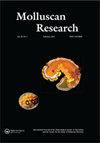Colchicum Ritchii flower: a new molluscicidal plant for Biomphalaria alexandrina snails and the infective stages of Schistosoma mansoni
IF 0.6
4区 生物学
Q3 ZOOLOGY
引用次数: 6
Abstract
ABSTRACT Schistosomiasis is considered a neglected disease, but it is the cause of many social and economic problems in many developing countries. The aim of the present study was to find an alternative molluscicide of botanical origin to decrease the spread of this disease. The investigation studied the effect of the methanolic extract of Colchicum ritchii flowers on Biomphalaria alexandrina snails, larvae of Schistosoma mansoni, and the freshwater cladoceran Daphnia magna. The preliminary phytochemical screening test confirmed the presence of tannins and saponins that might be responsible for cytotoxic effects. The methanolic extract had a molluscicidal activity on B. alexandrina snails with an LC50 of 35.1 mg L−1 after 24 h of exposure. The LC50 of D. magna after 24 h was 63.5 mg L−1. The extract also had a larvicidal activity and caused alterations in the haemocytes of B. alexandrina snails. Aggregations of both hyalinocytes and granulocytes were formed after exposure for 24 h to LC25. Both the mean number of micronuclei per slide and the olive tail moment of snails exposed to LC10 and LC25 of the extract were increased compared to control snails. In conclusion, C. ritchii extract potentially could be used as a molluscicide and larvicide.秋水仙花:一种新的杀螺植物——亚历山大蜗牛和曼氏血吸虫感染阶段
血吸虫病被认为是一种被忽视的疾病,但它是许多发展中国家许多社会和经济问题的原因。本研究的目的是寻找一种植物来源的替代杀螺剂,以减少这种疾病的传播。研究了秋水仙花甲醇提取物对亚历山大蜗牛、曼氏血吸虫幼虫和大型水蚤的影响。初步的植物化学筛选试验证实了可能导致细胞毒性作用的单宁和皂苷的存在。甲醇提取物对亚历山大蜗牛具有杀螺活性,暴露24小时后的LC50为35.1 mg L−1。24小时后,大型D.magna的LC50为63.5 mg L−1。该提取物还具有杀幼虫活性,并引起亚历山大蜗牛血细胞的改变。透明细胞和粒细胞在暴露于LC25 24小时后形成聚集。与对照蜗牛相比,暴露于提取物的LC10和LC25的蜗牛的每张玻片的平均微核数和橄榄尾矩都增加了。总之,锦葵提取物具有潜在的杀螺和杀幼虫作用。
本文章由计算机程序翻译,如有差异,请以英文原文为准。
求助全文
约1分钟内获得全文
求助全文
来源期刊

Molluscan Research
生物-动物学
CiteScore
1.80
自引率
10.00%
发文量
27
审稿时长
>12 weeks
期刊介绍:
Molluscan Research is an international journal for the publication of authoritative papers and review articles on all aspects of molluscan research, including biology, systematics, morphology, physiology, ecology, conservation, biogeography, genetics, molecular biology and palaeontology.
While the scope of the journal is worldwide, there is emphasis on studies relating to Australasia and the Indo-west Pacific, including East and South East Asia. The journal’s scope includes revisionary papers, monographs, reviews, theoretical papers and briefer communications. Monographic studies of up to 73 printed pages may also be considered.
The journal has been published since 1957 (as the Journal of the Malacological Society of Australia until 1993). It is free to members of the Malacological Society of Australasia and the Society for the Study of Molluscan Diversity.
 求助内容:
求助内容: 应助结果提醒方式:
应助结果提醒方式:


